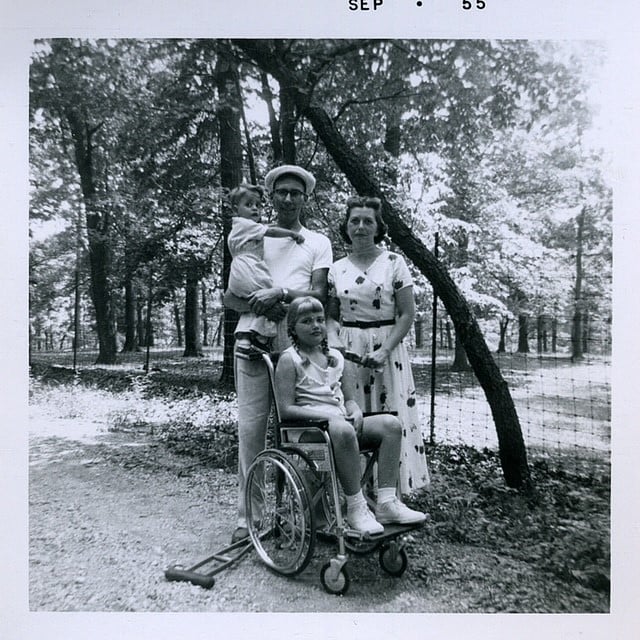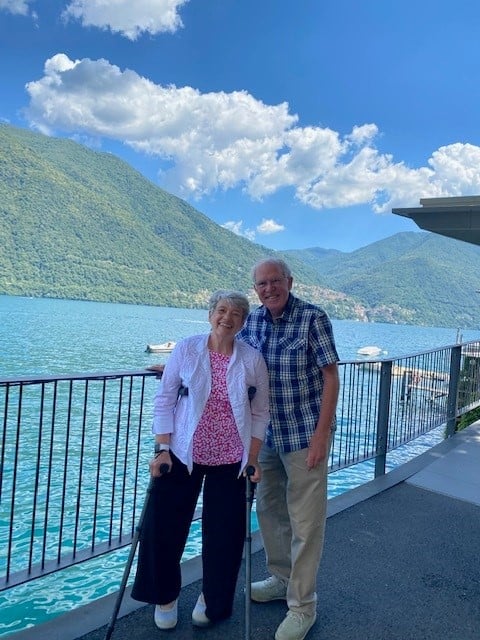A polio survivor shares her story
Facebook Twitter LinkedIn Email
As a child in suburban Chicago, Cami contracted polio just months before the polio vaccine was licensed in the U.S. in 1955. Now 75, she recently responded to several questions from Science Speaks, reflecting on how the disease has affected her life, how she overcame obstacles, the challenges she faces now with post-polio syndrome and the importance of immunization.
When you contracted polio, what was it like, in terms of your symptoms, treatment and physical therapy?
It was early September. I was 7 years old and looking forward to beginning second grade. One evening I was getting ready for bed, and I didn’t feel well. I had a fever, and my mom thought I might be coming down with the flu. When I woke up the next morning, I was feeling very achy all over, and I sat up on the side of my bed. But when I tried to stand, I couldn’t do it. I was scared and called out for my mom. By the time she ran up the stairs (my voice must have sounded panicky to her), I was lying on my back, and pretty quickly I couldn’t really move.
Of course, the family doctor was called. He quickly determined I needed to be hospitalized. On that emergency basis, the first available quarantine bed was at Cook County Hospital. Memories from that initial time are sparse, but I know I was upset to be put in a bed that was like a metal crib (I wasn’t a baby) and that someone had to spoon feed me. Another strong memory was extreme pain everywhere when I was carried in the nurse’s arms to be bathed.
When my two-week quarantine ended, I could be transferred to the private Mercy Hospital, where our family doctor was affiliated. Here I began the treatment of having my limbs gently moved and packed in moist heat. After many weeks, I graduated to walking with support while holding on to parallel bars on each side. I was a cooperative and trusting patient, doing as I was told and working hard — believing that I would eventually be “all better.” I don’t think I left the hospital until I was discharged four months later at Christmas.
What limitations did you have on your mobility? How did you respond to them?
Fortunately, the farsighted principal of my Catholic elementary school, run by the Springfield Dominican sisters, was sympathetic to my mother’s assurances that with the use of my wheelchair I could return to my “normal” school. Through regular physical therapy, both outside and in my home (the March of Dimes funded some training for my mother to eventually take over my therapy regimen), by May I was able to use crutches and the support of full-length braces to walk up the aisle of our church on my own with my classmates for my First Holy Communion ceremony. This was a goal I had insisted I would accomplish.
My dad drove me to a pool twice a week for swimming exercise. Together with my best friend, Arlene, self-appointed helper and wheelchair driver, there wasn’t anything we thought I couldn’t do, so I just kept pushing the envelope of challenging myself to keep up with my peers. By the time I was leaving for high school, I was walking and climbing stairs well with crutches and without braces.
High school is a whole new experience for everyone — a new beginning, with new challenges. For me, changing classes on a time limit while carrying books was among the most difficult. But I found I could hang a carrying bag on my crutch armrest. And my chosen school had an elevator, so stairs were not a problem. I made new friends easily, and they were generous helpers.
In fact, I have always depended on the good will and open hearts of others. Friendship is a foundation of my well-being, and I guess I was blessed with a positive attitude, sunny personality and optimistic outlook that drew people to my side. Thanks to my parents and family, I really didn’t see myself as “handicapped,” so I imagine most others took their cue from me.
 What related challenges are you facing now, later in life, as a polio survivor?
What related challenges are you facing now, later in life, as a polio survivor?
I turned 75 this year. I have been diagnosed with post-polio syndrome, and a new reality in my life is two full-length braces that allow me to continue my mobility with the use of crutches for easier functioning around the house. The braces were necessary to stabilize my weakening legs and unstable knee joints.
However, because of a decrease in muscle capacity with PPS, I have a limited capability for distance walking, and the braces affect balance and increase my susceptibility to falls. I notice a slight increase in fatigue, partly because of overcoming the awkwardness associated with the braces. For example, it’s more difficult to rise from a seated position.
But with the support of husband and family, and in a home designed to accommodate my limitations (e.g., a roll-in shower using a shower wheelchair, hardwood floors throughout, all necessary rooms on one level), I lead an active life. This includes extensive travel, one of the joys of our life. But this is dependent on using a standard wheelchair; finding the necessary accessible accommodations; and on the love, good health and fitness of my husband, who is my energetic “pusher” and willing enabler.
He has also assumed responsibility for many household chores like laundry and grocery shopping, and although our car is equipped with hand controls, he now does all the driving because I cannot dependably walk any distance alone once I have reached a destination. We also have a weekly cleaning service.
What perspective has polio and living with its effects given you about the importance of immunization, including as a parent?
My perspective is particularly poignant because I contracted polio just months before the polio vaccine was made available nationally. My mother made sure all of her children were appropriately vaccinated, and I know that it broke her heart to watch her child struggle with a disease she had no way to prevent. Yet she labored tirelessly to learn from the training offered her by the March of Dimes to assist me with every step of the way with such necessities as physical therapy, diet, and moral support to as complete a recovery as possible … all the while caring for my teenage brother and two lively toddlers as well as the constant responsibilities of being a homemaker.
You can bet that our two children were completely vaccinated on a timely schedule. I find it nearly impossible to understand how any parent would consciously reject the means to protect a child with vaccines that have been proven safe through careful research. Actually, I find it frightening and horrifying, and irresponsible.
What message do you have for those who may not be familiar with the impact of vaccine-preventable diseases like polio, measles and others, and forego immunizations that protect against them?
I would beg them to open their minds to basic facts and their hearts to first-person stories such as mine. Learn what is happening in developing countries where some of the diseases we already have the ability to eradicate can still cause tragic harm to innocents. And recent cases of polio in New York City should surely be a wake-up call that this virus and others are lurking in wait for a host.
Ask questions of your physician. Observe the successful results of the safe vaccines available. And realize what you could be condemning yourself and your children to by refusing a safe procedure that responsible and dedicated research has provided you.


